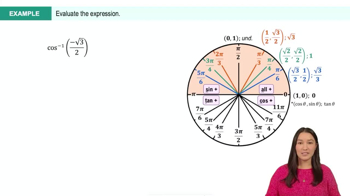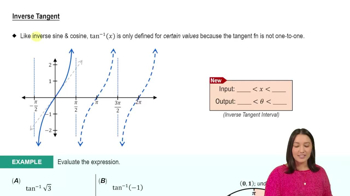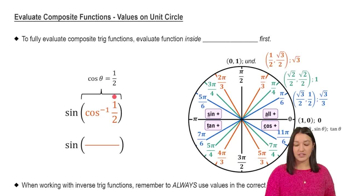Table of contents
- 0. Functions7h 52m
- Introduction to Functions16m
- Piecewise Functions10m
- Properties of Functions9m
- Common Functions1h 8m
- Transformations5m
- Combining Functions27m
- Exponent rules32m
- Exponential Functions28m
- Logarithmic Functions24m
- Properties of Logarithms34m
- Exponential & Logarithmic Equations35m
- Introduction to Trigonometric Functions38m
- Graphs of Trigonometric Functions44m
- Trigonometric Identities47m
- Inverse Trigonometric Functions48m
- 1. Limits and Continuity2h 2m
- 2. Intro to Derivatives1h 33m
- 3. Techniques of Differentiation3h 18m
- 4. Applications of Derivatives2h 38m
- 5. Graphical Applications of Derivatives6h 2m
- 6. Derivatives of Inverse, Exponential, & Logarithmic Functions2h 37m
- 7. Antiderivatives & Indefinite Integrals1h 26m
- 8. Definite Integrals4h 44m
- 9. Graphical Applications of Integrals2h 27m
- 10. Physics Applications of Integrals 2h 22m
0. Functions
Inverse Trigonometric Functions
Problem 3.10.62a
Textbook Question
62–65. {Use of Tech} Graphing f and f'
a. Graph f with a graphing utility.
f(x) = (x−1) sin^−1 x on [−1,1]
 Verified step by step guidance
Verified step by step guidance1
Step 1: Understand the function f(x) = (x - 1) sin^−1(x). This function is composed of two parts: a linear term (x - 1) and the inverse sine function sin^−1(x). The domain of sin^−1(x) is [-1, 1], which matches the interval given for graphing.
Step 2: Use a graphing utility to plot the function f(x) over the interval [-1, 1]. Ensure that the graphing tool can handle inverse trigonometric functions and is set to the correct interval.
Step 3: Analyze the graph of f(x). Look for key features such as intercepts, maxima, minima, and points of inflection. Note how the linear term (x - 1) affects the shape of the graph in combination with sin^−1(x).
Step 4: To graph f'(x), first find the derivative of f(x). Use the product rule for differentiation, which states that if you have a function h(x) = u(x)v(x), then h'(x) = u'(x)v(x) + u(x)v'(x). Apply this to f(x) = (x - 1) sin^−1(x).
Step 5: After finding f'(x), use the graphing utility to plot the derivative over the same interval [-1, 1]. Compare the graphs of f(x) and f'(x) to understand how the derivative reflects the rate of change and behavior of the original function.
 Verified video answer for a similar problem:
Verified video answer for a similar problem:This video solution was recommended by our tutors as helpful for the problem above
Video duration:
4mPlay a video:
Was this helpful?
Key Concepts
Here are the essential concepts you must grasp in order to answer the question correctly.
Graphing Functions
Graphing functions involves plotting points on a coordinate system to visualize the behavior of the function. For the function f(x) = (x−1) sin^−1 x, understanding its domain and range is crucial, especially since it is defined on the interval [-1, 1]. A graphing utility can help illustrate key features such as intercepts, maxima, minima, and asymptotic behavior.
Recommended video:

Graph of Sine and Cosine Function
Inverse Sine Function
The inverse sine function, denoted as sin^−1 x or arcsin x, is the function that returns the angle whose sine is x. Its range is limited to [-π/2, π/2], which is important when analyzing the function f(x) = (x−1) sin^−1 x. Understanding how this function behaves within its domain helps in predicting the overall shape of f.
Recommended video:

Inverse Sine
Derivative and Its Graph
The derivative of a function, denoted as f', represents the rate of change of the function with respect to its variable. Graphing f' provides insights into the function's increasing or decreasing behavior, as well as its critical points. For f(x) = (x−1) sin^−1 x, calculating f' will reveal where the function has local maxima or minima, which is essential for a complete analysis.
Recommended video:

Graphing The Derivative
Related Videos
Related Practice












